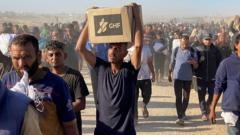In the early hours of Tuesday, chaos erupted at a new aid distribution site in southern Gaza, where Israeli troops reportedly opened fire on Palestinians urgently seeking food. Eyewitness accounts described the scene as “total carnage,” markedly contrasting with the Israeli military’s official narrative claiming gunfire was directed only at “suspects” straying from designated paths.
Criticism is mounting against the Gaza Humanitarian Foundation (GHF)—the newly established conduit for aid, promoted by Israel and supported by the U.S., in place of the more established UN agencies. Following stringent Israeli restrictions on food imports, the GHF was set up to prevent famine, but the system has already shown significant flaws, as highlighted by the recent resignation of its head, Jake Wood. Wood cited the inability to adhere to the humanitarian principles expected of such an organization.
The UN, which previously maintained an extensive aid network, has refused to cooperate with the GHF, citing the risks and chaos that the new system poses for ordinary citizens trying to access essential supplies. Tens of thousands are now forced into precarious conditions just to collect meal rations, often leading to deadly confrontations with military forces.
International figures, including UN officials, have condemned the GHF’s approach, arguing it reflects a blatant disregard for civilian safety and rights within a war zone. Calls for change from allies of Israel, including the UK, are growing stronger, with some Western governments threatening to impose sanctions if the situation does not improve swiftly.
As frustrations increase on the ground and globally, the tragic events near the aid center force a reckoning on the efficacy and ethics of the aid distribution strategies in Gaza.
Criticism is mounting against the Gaza Humanitarian Foundation (GHF)—the newly established conduit for aid, promoted by Israel and supported by the U.S., in place of the more established UN agencies. Following stringent Israeli restrictions on food imports, the GHF was set up to prevent famine, but the system has already shown significant flaws, as highlighted by the recent resignation of its head, Jake Wood. Wood cited the inability to adhere to the humanitarian principles expected of such an organization.
The UN, which previously maintained an extensive aid network, has refused to cooperate with the GHF, citing the risks and chaos that the new system poses for ordinary citizens trying to access essential supplies. Tens of thousands are now forced into precarious conditions just to collect meal rations, often leading to deadly confrontations with military forces.
International figures, including UN officials, have condemned the GHF’s approach, arguing it reflects a blatant disregard for civilian safety and rights within a war zone. Calls for change from allies of Israel, including the UK, are growing stronger, with some Western governments threatening to impose sanctions if the situation does not improve swiftly.
As frustrations increase on the ground and globally, the tragic events near the aid center force a reckoning on the efficacy and ethics of the aid distribution strategies in Gaza.
















